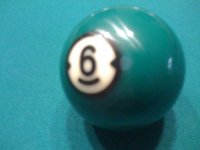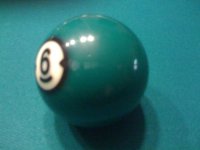Thank you for offering. I would love to have one.Now if we all had one of those JT laser gizmos these discussions would be much more productive
Regards,
Dave
Thank you for offering. I would love to have one.Now if we all had one of those JT laser gizmos these discussions would be much more productive
I'm not a master but here is an idea on how long:
A hundred hours to get started mastering inside english. A thousand to have decent mastery. A lifetime isn't long enough to totally master it.
Hu
Here's 3 quickies, real busy trying to get things (and myself) ready for next week.
With this ball frozen to the cushion most instruction I’ve seen tells the beginner that they must strike the cushion first so the object ball won’t be thrown into the cushion. If that’s the case I could never get 3 rails around on this shot.
http://CueTable.com/P/?@2HbFl4IEvh3QJIC3lJIC2laXT1lIne1lbJE3laST3lOJh@
Here’s a shot with a top rated pro player telling people to aim full 3-4 inches to the end rail cuz you’re going to throw it in, while making no mention of squirt.. At that speed and distance I think that’s crazy.
http://CueTable.com/P/?@1HIaY3IHpe4QHFX4lHFX1lHkJ5lCmT6lEia6lOVT2laft4lPnG@
I believe in collision induced throw and that inside and/or outside can help to reduce it and this is where many players say they threw it in when I believe they actually hit the correct contact point but reduced the collision induced throw.
http://CueTable.com/P/?@2HAuo4QCVU4lCVU1lBsl1lDYj1lbAP3lKyR@
make sure you get pretty far out to the side (not absurd amounts but at least halfway between center and edge)
I always felt/heard that halfway between center and edge is maximum effect, yet certain shots seem to call call for going beyond that point. I'm not sure if those shots are just being hit improperly and could be accomplished with the halfway-offset... or if some shots just need "beyond maximum" due to the physics of the shot.
I don't think that ... shot is makable for all but a few pros. And even they wouldn't go that route. They'd draw the ball two rails for position. Much easier. With the eight ball one diamond below the side pocket and the cue ball at that angle, you can forget about shooting that shot. You could practice that one all day and never get the cue ball to the end rail, let alone three rails back up table.
It can be done. I just did it once in five tries, but I caught the end rail about half a diamond from the corner pocket. A very low percentage shot IMO.
Patrick, are you saying that it's physically not possible to hit further out than "halfway between center and edge"? Because it very much is possible. The only doubt in my mind is whether it's useful (and maybe in some cases necessary). Maybe we define that halfway point differently somehow.


Patrick: I'll try experimenting more tonight and see if I'm maybe subconsciously steering my stroke to not hit as far out as I thought, or something like that.
I don't know if it qualifies as any sort of 'proof' of anything but in one of Bert Kinister vids, secrets of shotmaking, he attempts to show how hitting way out to the side of a ball doesn't result in a miscue. His test (maybe less than scientific) has him holding onto a ball and having a player press the tip of the cue into that ball far out to the edge, to the point where half the tip is almost showing. The tip doesn't slide off the edge of the ball until he's really far out there (hard to describe it but way outside the centennial circle anyway).
Still, you'd be right to expect actual shooting tests rather than setups like this. So I'll try them. It may have something to do with pivoting too?
Welp, I tried it, and I was dead wrong. When I use "maximum" english, I'm not hitting nearly as far out to the side as I thought I was. I tried your centennial test and even hitting the very edge of the number ring felt like a ton of spin. I got a couple of balls to go hitting a bit outside of it, but what I thought of as "3 tips" of sidespin was more like 2. And it felt like I was on the verge of miscuing and the ball deflected quite a bit.
In the future when I tell people how much english to put on a ball I'll have to come up with something other than "halfway between center and edge" because in most cases that's overkill for whatever shot they're trying.
Even if you could make contact significantly beyond (1/2)R without slippage, it wouldn't do you any good - at least not without some major modifications to the standard cue. But as far Mr. Kinister's demonstration, if they really were well beyond (1/2)R, I can't think of a reason the tip wouldn't slip other than that maybe the player was pushing the tip toward the cueball, consciously or subconsciously.....I don't know if it qualifies as any sort of 'proof' of anything but in one of Bert Kinister vids, secrets of shotmaking, he attempts to show how hitting way out to the side of a ball doesn't result in a miscue. His test (maybe less than scientific) has him holding onto a ball and having a player press the tip of the cue into that ball far out to the edge, to the point where half the tip is almost showing. The tip doesn't slide off the edge of the ball until he's really far out there (hard to describe it but way outside the centennial circle anyway).